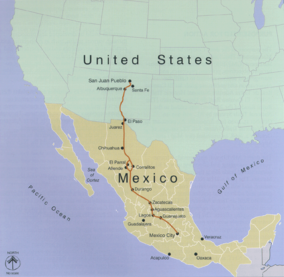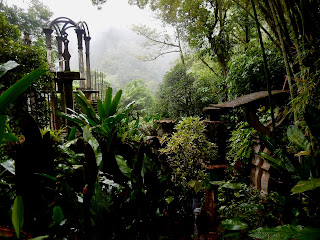Mexico’s Camino Real, the “Silver Route”
Mexico’s has an historic route called the Camino Real or, more formally, the “Camino Real de Tierra Adrentro” (“Royal Road of Interior Land”), a commercial route that extended from the Valley of Mexico to Sante Fe, New Mexico (16th – 19thcenturies). The route, then a trail traveled by foot, horses and wagons, included many outposts –forts, haciendas and chapels- to protect the Spanish travelers from attacks by indigenous peoples, especially the Chichimecas. The route was also called La Ruta de la Plata (“The Silver Route”), because it followed a chain of volcanically formed mountains where minerals such as silver, gold, copper, turquoise and salt were mined. The 2,560-kilometer (1600-mile) route, now an UNESCO World Heritage Site (Patrimonial Mundial), has 59 historic points along the way.
This route was well established by indigenous kingdom and tribes long before the Spanish arrived in the 16thcentury. Elcamino, used for hunting and trade, connected important locations in Meso-America and the Rocky Mountains by the year 1000. The route follows the long, rugged Sierra Padre Mountain chain, emblematic of the breathtaking “Western” landscape.
 |
| El Centro Historico, San Miguel de Allende |
Many of the pueblos in this blog or in my book projects are either directly on el Camino (Guanajuato City, San Miguel de Allende, Sombrerete) - or were functioning offshoots, such as Dolores Hidalgo, Mineral de Pozos, Calvillo, Real de Asientos, Pinos and Nochistlán. The adjacent off-shoot towns provided essential services for mining and traveling on the Camino Real, such as security out-posts, banking, supplies and food sources like ranching and farming (San Miguel de Allende, Dolores Hidalgo).
 |
| Sombrerete, a Pueblo Mágico on El Camino Real |
Many of these pueblos have historic Camino Real sites and structures such as churches, bridges, cemeteries, mines, aqueducts, etc.. El Camino now consists mostly of highways and roads that connect or link the recognized sites and structures. Many of these sites are fascinating and scenic subject matter for painting or photography. I urge you to visit them.
 |
| The Historic Church/Convento, Atotonilco (San Miguel de Allende) |
My current residence in San Miguel de Allende is on the official route; and several painting locations in my book are Patrimonial Mundial sites. I intend to emphasize, whenever feasible, these captivating sites in future writings.
 |
| Pinos, Pueblo Mágico-an Old God & Silver Town. |
The follow link summarizes the Camino Real clearly and succinctly:
https://en.wikipedia.org/wiki/Camino_Real_de_Tierra_Adentro

















